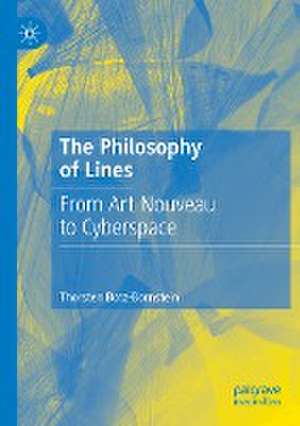The Philosophy of Lines: From Art Nouveau to Cyberspace
Autor Thorsten Botz-Bornsteinen Limba Engleză Paperback – 2 feb 2022
| Toate formatele și edițiile | Preț | Express |
|---|---|---|
| Paperback (1) | 694.72 lei 6-8 săpt. | |
| Springer International Publishing – 2 feb 2022 | 694.72 lei 6-8 săpt. | |
| Hardback (1) | 699.20 lei 6-8 săpt. | |
| Springer International Publishing – feb 2021 | 699.20 lei 6-8 săpt. |
Preț: 694.72 lei
Preț vechi: 817.32 lei
-15% Nou
Puncte Express: 1042
Preț estimativ în valută:
132.95€ • 137.35$ • 110.65£
132.95€ • 137.35$ • 110.65£
Carte tipărită la comandă
Livrare economică 25 martie-08 aprilie
Preluare comenzi: 021 569.72.76
Specificații
ISBN-13: 9783030653453
ISBN-10: 3030653455
Ilustrații: IX, 259 p. 6 illus., 3 illus. in color.
Dimensiuni: 148 x 210 mm
Greutate: 0.36 kg
Ediția:1st ed. 2021
Editura: Springer International Publishing
Colecția Palgrave Macmillan
Locul publicării:Cham, Switzerland
ISBN-10: 3030653455
Ilustrații: IX, 259 p. 6 illus., 3 illus. in color.
Dimensiuni: 148 x 210 mm
Greutate: 0.36 kg
Ediția:1st ed. 2021
Editura: Springer International Publishing
Colecția Palgrave Macmillan
Locul publicării:Cham, Switzerland
Cuprins
1. Introduction.- Part I What is a Line?.- 2. Strings, Traces, and Structures.- 3. Lines in Modern Societies.- Part II Lines: An Aesthetics of Disappearance.- 4. Differential Lines.- 5. Dynamic Lines.- 6. Drawing as Thinking.- 7. Non-Euclidean Geometry.- 8. “The Movement That the Eye Cannot See:” Flexuous Line.- Part III Living Lines of the East.- 9. Calligraphic Lines.- 10. Organic Lines of the East.- 11. Dream Lines.- 12. Two Kinds of Virtual Realities.- 13. Conclusion.
Notă biografică
Thorsten Botz-Bornstein is Associate Professor of philosophy at Gulf University for Science and Technology in Kuwait.
Textul de pe ultima copertă
This book offers a philosophical exploration of lines in art and culture, and traces their history from Antiquity onwards. Lines can be physical phenomena, cognitive responses to observed processes, or both at the same time. Based on this assumption, the book describes the “philosophy of lines” in art, architecture, and science. The book compares Western and Eastern traditions. It examines lines in the works of Paul Klee, Wassily Kandinsky, and Henri Michaux, as well as in Chinese and Japanese art and calligraphy. Lines are not merely a matter of aesthetics but also reflect the psychological states of entire cultures. In the nineteenth century, non-Euclidean geometry sparked the phenomenon of the “self-negating line,” which influenced modern art; it also prepared the ground for virtual reality. Straight lines, distorted lines, blurred lines, hot and cold lines, dynamic lines, lines of force, virtual lines, and on and on, lines narrate the development of human civilization.Thorsten Botz-Bornstein is Associate Professor of philosophy at Gulf University for Science and Technology in Kuwait.
Caracteristici
Offers a philosophical exploration of lines in art and culture Traces the history of lines from Antiquity onwards Written for scholars of philosophy, art, and architecture
